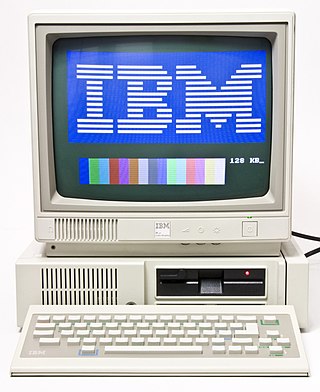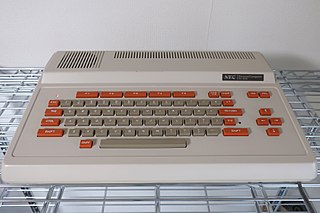
The Tandy 1000 is the first in a line of IBM PC compatible home computer systems produced by the Tandy Corporation for sale in its Radio Shack and Radio Shack Computer Center chains of stores. Introduced in 1984, the product line was aimed at providing affordable but capable systems for home computing or education, with some of its Tandy specific features like graphics, sound and joystick port making it more appealing for home use.

The IBM PCjr was a home computer produced and marketed by IBM from March 1984 to May 1985, intended as a lower-cost variant of the IBM PC with hardware capabilities better suited for video games, in order to compete more directly with other home computers such as the Apple II and Commodore 64.

Ichitaro is a Japanese word processor produced by JustSystems, a Japanese software company. Ichitaro occupies the second share in Japanese word-processing software, behind Microsoft Word. It is one of the main products of the company. Its proprietary file extension is ".JTD". ATOK, an IME developed by JustSystems, is bundled with Ichitaro.

Compaq's first computers' form factors were portable, also called "luggables", and then "lunchbox computers", and together constituted the Compaq Portable series. These computers measured approximately 16 inches (410 mm) deep, 8 inches (200 mm) tall, and approximately 20 inches (510 mm) wide. As the products evolved, laptops and notebooks were created offing a new level of portability that caused the market to explode.

The PC-8800 series, commonly shortened to PC-88, are a brand of Zilog Z80-based 8-bit home computers released by Nippon Electric Company (NEC) in 1981 and primarily sold in Japan.

DOS/V is a Japanese computing initiative starting in 1990 to allow DOS on IBM PC compatibles with VGA cards to handle double-byte (DBCS) Japanese text via software alone. It was initially developed from PC DOS by IBM for its PS/55 machines, but IBM gave the driver source code to Microsoft, who then licensed a DOS/V-compatible version of MS-DOS to other companies. Kanji fonts and other locale information are stored on the hard disk rather than on special chips as in the preceding AX architecture. As with AX, its great value for the Japanese computing industry is in allowing compatibility with foreign software. This had not been possible under NEC's proprietary PC-98 system, which was the market leader before DOS/V emerged. DOS/V stands for "Disk Operating System/VGA". In Japan, IBM compatible PCs became popular along with DOS/V, so they are often referred to as "DOS/V machine" or "DOS/V pasocom" even though DOS/V operating systems are no longer common.

The Compaq Portable is an early portable computer which was one of the first IBM PC compatible systems. It was Compaq Computer Corporation's first product, to be followed by others in the Compaq Portable series and later Compaq Deskpro series. It was not simply an 8088-CPU computer that ran a Microsoft DOS as a PC "work-alike", but contained a reverse-engineered BIOS, and a version of MS-DOS that was so similar to IBM's PC DOS that it ran nearly all its application software. The computer was also an early variation on the idea of an "all-in-one".

The PC-9800 series, commonly shortened to PC-98 or 98, is a lineup of Japanese 16-bit and 32-bit personal computers manufactured by NEC from 1982 to 2000. The platform established NEC's dominance in the Japanese personal computer market, and, by 1999, more than 18 million units had been sold. While NEC did not market these specific machines in the West, it sold the NEC APC series, which had similar hardware to early PC-98 models.

The NEC PC-6000 series is a series of 8-bit home computers introduced in November 1981 by NEC Home Electronics. There are several models in this series, such as the PC-6001, the PC-6001 MK2 and the PC-6001 MK2 SR. There is also an American version, called the NEC TREK or NEC PC-6001A.

The PC-8000 series is a line of personal computers developed for the Japanese market by NEC. The PC-8001 model was also sold in the United States and Canada as the PC-8001A.
The Sanyo MBC-550 is a small and inexpensive personal computer in "pizza-box" style, featuring an Intel 8088 microprocessor and running a version of MS-DOS. Sold by Sanyo, it was the least expensive early IBM PC compatible and followed Sanyo's MBC-1000 line of CP/M computers.

IBM 5550 is a personal computer series that IBM marketed in Japan, Korea, Taiwan and China in the 1980s and 1990s, for business use customers. In Japan, it was introduced in 1983 and promoted as "Multistation 5550 (マルチステーション5550)" because it had three roles in one machine: a PC, a word processing machine which was traditionally marketed as a machine different from a PC in Japan, and an IBM-host attached terminal.

The APC was a series of business microcomputers released outside of Japan by the NEC Corporation. The series comprised the APC, the APC II and APC III, international versions of models from the Japanese NEC N5200 series.

Home computers were a class of microcomputers that entered the market in 1977 and became common during the 1980s. They were marketed to consumers as affordable and accessible computers that, for the first time, were intended for the use of a single, non-technical user. These computers were a distinct market segment that typically cost much less than business, scientific, or engineering-oriented computers of the time, such as those running CP/M or the IBM PC, and were generally less powerful in terms of memory and expandability. However, a home computer often had better graphics and sound than contemporary business computers. Their most common uses were word processing, playing video games, and programming.

PFU Limited is a Japanese information technology company jointly owned by Ricoh and Fujitsu. The company was formed by the merger of Panafacom and USAC Electronic Industrial in 1987.
The IBM Personal Computer Basic, commonly shortened to IBM BASIC, is a programming language first released by IBM with the IBM Personal Computer, Model 5150 in 1981. IBM released four different versions of the Microsoft BASIC interpreter, licensed from Microsoft for the PC and PCjr. They are known as Cassette BASIC, Disk BASIC, Advanced BASIC (BASICA), and Cartridge BASIC. Versions of Disk BASIC and Advanced BASIC were included with IBM PC DOS up to PC DOS 4. In addition to the features of an ANSI standard BASIC, the IBM versions offered support for the graphics and sound hardware of the IBM PC line. Source code could be typed in with a full-screen editor, and very limited facilities were provided for rudimentary program debugging. IBM also released a version of the Microsoft BASIC compiler for the PC, concurrently with the release of PC DOS 1.10 in 1982.

The Personal System/55 (パーソナルシステム/55) or PS/55 is a personal computer series released from IBM Japan in 1987.

Personal Editor (PE) and Personal Editor II (PE2) was a text editor developed by IBM for IBM PC DOS and MS-DOS in the 1980s. It became popular because of its easy, fast, and programmable user interface. PE influenced its successor text editors, such as Personal Editor 32, a modern 32-bit editor with a user interface based on PE2/PE3, and QE, a text editor for Linux systems. Personal Editor 3 is an open source implementation for 64 bit Linux and Windows 10+ running Intel compatible processors, implemented using the SNOBOL5 programming language.
IBM Fujisawa—located in Fujisawa, Kanagawa, Japan—was a manufacturing and development site of IBM Japan, Ltd., a subsidiary of IBM Corporation.



















